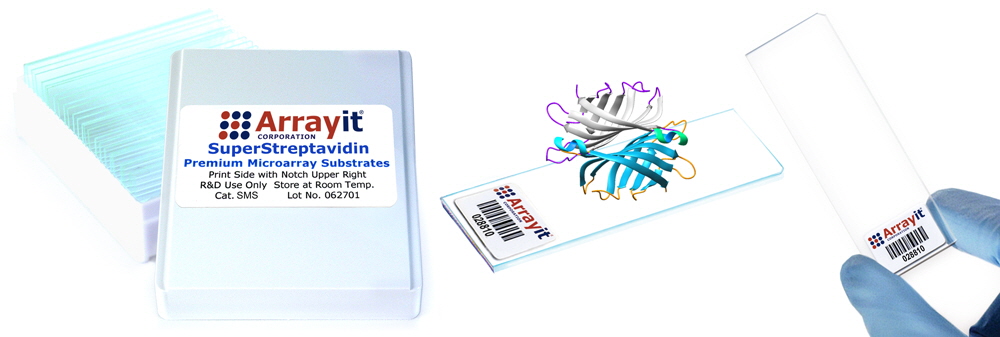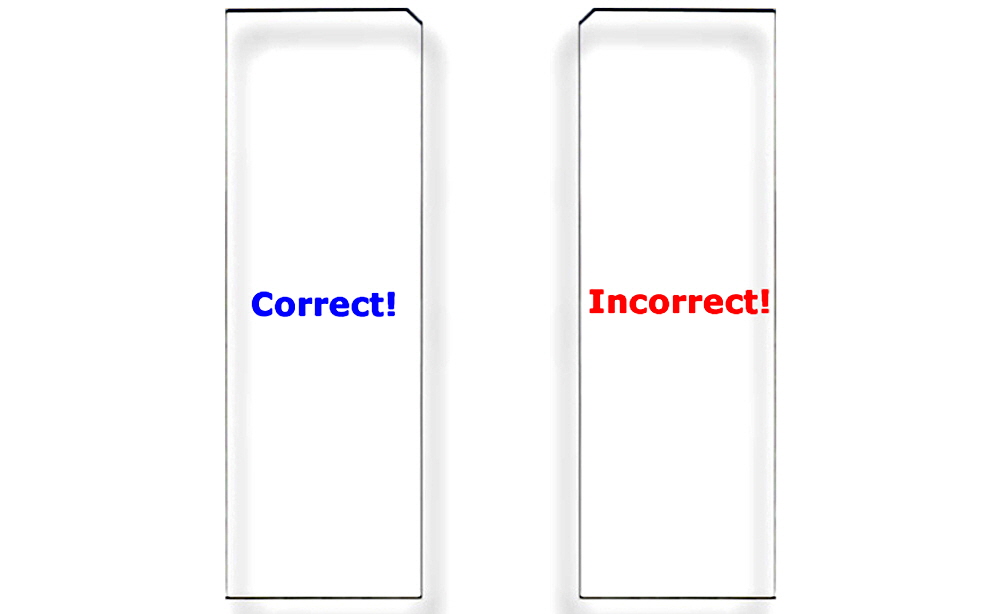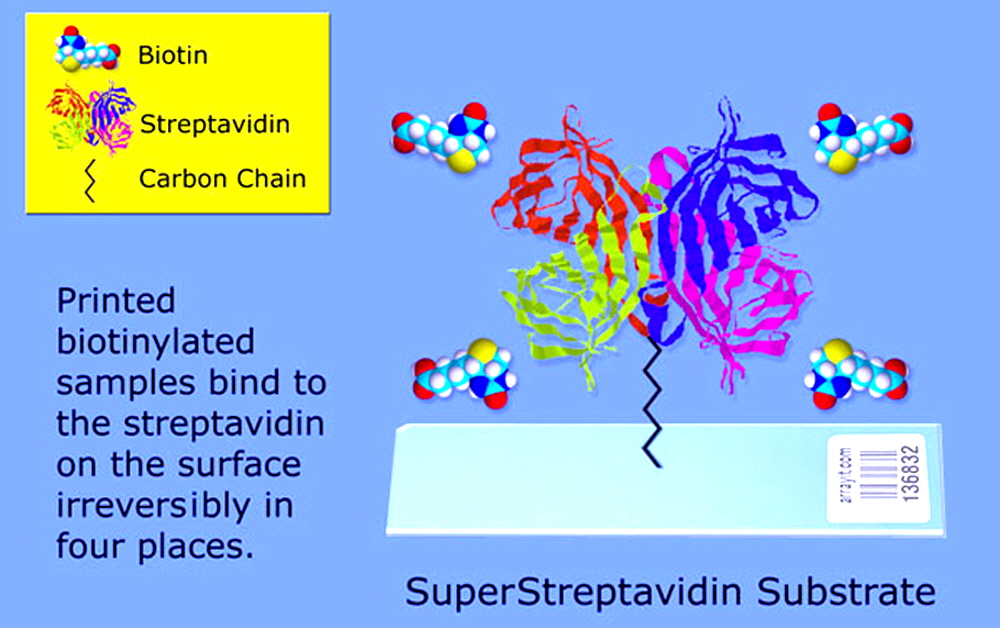SuperStreptavidin
Data Sheet
![]() Shop this product in our online store
Shop this product in our online store
Products - Microarray Substrates & Slides - SuperStreptavidin Activated Substrate Slides for Microarray Manufacturing and Next Generation Sequencing with Biotinylated Samples

ArrayIt® SuperStreptavidin Microarray Substrate Slides contain a highly uniform streptavidin treatment covalently bound to an atomically flat glass substrate, affording a universal high-capacity biotin-binding surface for DNA and protein microarray applications and many other life sciences applications including next generation sequencing (NGS) that require a biotin binding surface. The open platform 1 x 25 x 76 mm glass substrate slide format ensures that SuperStreptavidin Microarray Substrate Slides are compatible with all standard microarrayers and scanners.
Table of Contents
- Introduction
- Quality Control
- Product Description
- Protocol DNA Microarray
- Protocol Protein Microarray
- Technical Specifications
- Technical Assistance
- Recommended Equipment
- Ordering Information
- Storage Conditions
- Warranty
Introduction
Congratulations on taking a big step towards improving the affordability, quality and speed of your genomics, biomedical, pharmaceutical and agricultural research. This booklet contains all the information required to take full advantage of Arrayit SuperStreptAvidin Microarray Substrates.
Quality Control
Arrayit takes every measure to assure the quality of our Arrayit Brand Super Microarray Substrates. The finest microarray biochip cleanroom research was used to develop these products. Rigorous quality control monitoring on a substrate-by-substrate basis guarantees that each these products conforms to the highest industry standards.
Product Description
This surface starts with ArrayIt SuperClean glass then it is activated with streptavidin to bind biotinylated biomolecules. Streptavidin is protein isolated from streptomycetes avidinii that has an irreversible binding affinity for biotin. The streptavidin is covalently bound to the surface and will not flake, crack or peel off. The surface as a low intrinsic background and has a high binding capacity. SuperClean is a highly polished glass surface with an optical smoothness tolerance of 50 angstroms over the entire 25mm x 76 mm surface area for optimum homogeneity; this new surface sets the highest quality standard for streptavidin-activated substrates for microarray applications. These substrates are packed in white slide boxes, vacuum packed and should be stored at 4°C.
Short Protocol Protein (Steps 1-7)
1. Suspend biotinylated protein samples in Protein Printing Buffer at 0.25-1 µg/µl.
2. Print protein samples onto SuperStrepavidin Substrates.
3. Block with SuperStreptavidin blocking buffer and then wash and dry the printed microarrays.
4. React the processed microarrays with fluorescent samples.
5. Wash the microarrays to remove un-reacted fluorescent material.
6. Scan the microarray to produce a fluorescent image.
7. Quantitate and model the fluorescent data.
Complete Protocol Protein (Steps 1-7)
1. Suspend biotinylated protein samples in 2X Protein Printing Buffer for a final protein concentration of 0.25-1 µg/µl. Perform transfers careful to prevent protein denaturation. Mix samples thoroughly prior to printing and transfer into 384-well microplates at 5-10 µl per well. Keep samples cold (4°C) at all times during sample preparation.
2. Print protein samples onto SuperStrepavidin Substrates. Use a Protein Edition Microarrayer such as the SpotBot® Pro or NanoPrint Protein Edition to print the biotinlylated protein samples on the SuperStreptavidin Substrates. Place the 384-well microplates onto the platen of the instrument and print the samples onto the glass SuperStreptavidin Substrate slides. For best results, make sure the microplates and glass slides remain at 4°C for the duration of the print run. Following the print run, incubate the printed substrate slides on the robot platen for 30 min at 4°C at ambient humidity, to allow binding of the biotyinlated proteins to the streptavidin molecules.
3. Block with SuperStreptavidin blocking buffer and then wash and dry the printed microarrays. Use a glass LifterSlip™ cover slip large enough to completely cover the printed microarray area. Place 100-200 µl of SuperStreptavidin Blocking Buffer onto the printed microarray and place a LifterSlip™ on top of the droplet of Blocking Buffer. Incubate for 60 min at 4°C or room temperature (20-25°C) to block the microarray surface. Following the blocking step, wash 3 times for 5 min each in 1X PBS and then for 10 sec in 0.1X PBS. Spin dry using a High Speed Microarray Centrifuge (Cat. MHC) and store the blocked microarrays in a slide box at 4°C.
4. React the processed microarrays with fluorescent samples. Use a LifterSlip™ and either hybridization cassettes or an automated hybridization station to react the processed microarrays with a fluorescent sample. Binding reactions are typically performed for 30-60 min at 4°C or room temperature (20-25°C), with fluorescent samples suspended in 1X SuperStreptavidin Blocking Buffer.
5. Wash the microarrays to remove un-reacted fluorescent material. Following the binding reaction, wash the microarrays 3 times for 5 min each in 1X PBS + 0.01% tween-20, and then for 10 sec in 0.1X PBS. Spin dry using a High Speed Microarray Centrifuge (Cat. MHC).
6. Scan the microarray to produce a fluorescent image. Use an Arrayit InnoScan® or SpotLight™ Microarray Scanner to obtain a 16-bit TIFF of the microarray.
7. Quantitate and model the fluorescent data. Use Arrayit Mapix software to quantify the TIFF data in preparation for data modeling.
Short Protocol DNA (Steps 1-7)
1. Suspend biotinylated DNA samples in Micro Spotting Solution Plus at 50uM final concentration.
2. Print DNA samples onto SuperStrepavidin Substrates.
3. Block with SuperStreptavidin blocking buffer and then wash and dry the printed microarrays.
4. Hybridize the processed microarrays with fluorescent probe.
5. Wash the microarrays to remove unreacted fluorescent probe.
6. Scan the microarray to produce a fluorescent image.
7. Quantitate and model the fluorescent data.
Technical Specifications:
SuperStreptavidin Microarray Substrates are not streptavidin-treated microscope slides! Atomically flat polished glass is used as the starting point for this product. Glass substrates of this quality routinely retail at $50-100 each from leading optical suppliers. Users will benefit from the following technical features:
- Glass polished to atomic smoothness (±20 angstroms)
- Only polished glass surface in the microarray industry
- Polishing improves topology and uniformity – keys to precise data
- Homogenous streptavidin proteins across the entire surface provide superior biotin binding
- Streptavidin molecules bound covalently to the glass substrate
- Streptavidin monolayer contains 1.1 x 10^10 streptavidin proteins per mm2
- Streptavidin monolayer binds 4.4 x 10^10 biotin molecules per mm2
- Streptavidin monolayer covers entire 25 x 76 mm surface area
- Vastly superior to unpolished optical quality glass from other vendors
- Ultimate streptavidin surface for high density microarray applications
- Ideal for contact and non-contact printing
- Used by high-volume microarray core facilities
- Manufactured in a state-of-the-art class 1 cleanrooms
- Ultra-low intrinsic fluorescence and background noise
- Open platform dimensions compatible with all major brands of microarrayers and scanners
- Precise physical dimensions (25 ± 0.2 mm x 76 ± 0.3 mm x 0.940 mm ± 0.025 mm)
- Proprietary corner chamfer (1.4 mm) provides unambiguous side and end orientation to simplify printing and processing
- Finished edges enhance user safety
- Excellent refractive index, transmission and hardness specifications
- Sophisticated anti-static packaging improves usability
- Offered with or without bar-codes
- Custom laser and chrome fiducials available upon request
- High-volume 100,000 piece per month manufacturing capabilities
- Product arrives “ready to use” with no additional processing required

Figure 2. Atomic Force Microscopy (AFM) analysis. Shown are AFM scans of the SuperClean Microarray Substrate Slide by Arrayit, Sunnyvale CA. Data are coded to a rainbow intensity scale, such that red data represents 5.0 nm or 50 angstroms. The substrates have an average smoothness of 2.0 nm or 20 angstroms, which corresponds to about 10 silicon dioxide bonds.

Figure 3. Correct Substrate Slide Orientation. Shown is a graphic of two ArrayIt® Microarray Substrates, showing the correct and incorrect orientation for use. In the correct orientation (blue graphic), the chamfer will be located in the upper right corner and samples should be printed on the side facing upward, which is the same side that contains the word “Correct!”. In the incorrect orientation (red graphic), the chamfer will be located in the upper left corner, placing the backside facing upward, which is the side that contains the word “Incorrect!”. Only one side of ArrayIt® Microarray Substrates is suitable for printing. Please print on the correct side only.

Figure 4. Arrayit offers the most advanced streptavidin microarray substrate slides on the market, featuring polished atomically smooth glass with a covalently bound streptavidin layer for ultra-high biotin binding capacity and low non-specific binding over the entire 25 x 76 mm area. Our streptavidin substrate slides are manufactured and packaged in class 1 cleanrooms to ensure premium quality and performance.
Technical Assistance
Please contact us if you have any comments, suggestions, or if you need technical assistance. By electronic mail: arrayit@arrayit.com(under the subject heading please type "ArrayIt® technical assistance").
Scientific Publications
Click here and here for recent scientific publications using ArrayIt® brand microarray products for streptavidin experimentation.
Recommended Equipment and Reagents
NanoPrint™ 2 Microarrayers
SpotBot® 4 Personal Microarrayers
InnoScan® Microarray Scanners
Microarray Hybridization Cassettes
High Throughput Wash Station
Microarray High-Speed Centrifuge
Protein Printing Buffer
BlockIt™ Blocking Buffer
Microarray Air Jet
Microarray Cleanroom Wipes
PCR Purification Kits
Micro-Total RNA Extraction Kit
MiniAmp mRNA Amplification Kit
Indirect Amino Allyl Fluorescent Labeling Kit
Universal Reference mRNA
Green540 and Red640 Reactive Fluorescent Dyes
Hybridization Buffers

